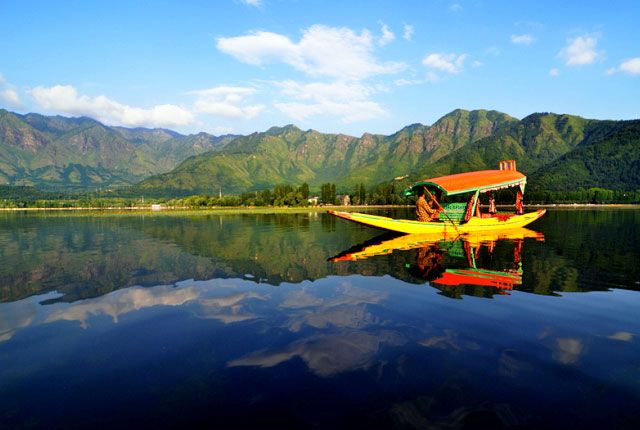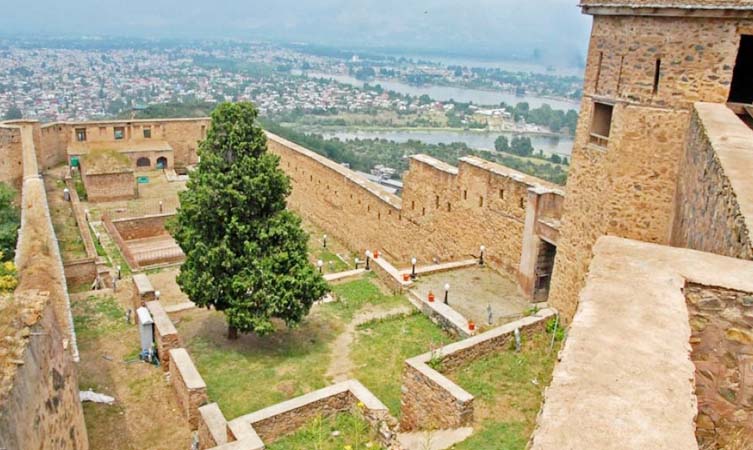
Hari Parbat Fort : A Majestic Landmark Overlooking Srinagar
Table of Contents
ToggleOverview
Hari Parbat Fort is located amidst the scenic beauty of Srinagar, in the picturesque Kashmir Valley. This historical and architectural marvel speaks volumes about centuries of cultural diversity, political turbulence, and artistic brilliance. The fort is situated atop the iconic Hari Parbat Hill, overlooking the stunning Dal Lake, which provides a panoramic view of the city. Hari Parbat Fort not only represents military architecture but it also stands tall as a massive cultural monument portraying the rich past and history of Jammu and Kashmir. A comprehensive guide has been designed here to take an extended journey to the history of the fort, its architecture, religious importance, and cultural implications.
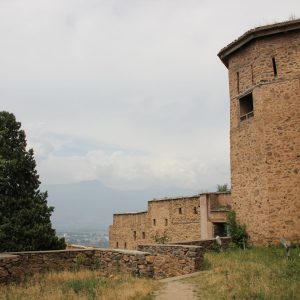
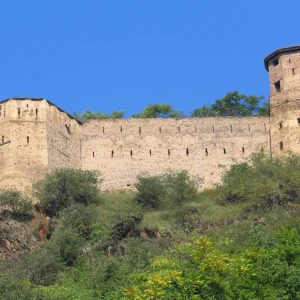
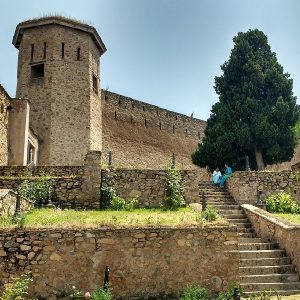
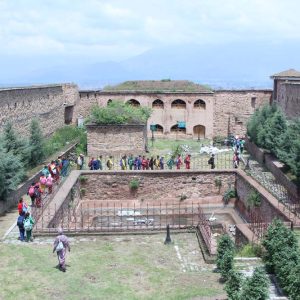
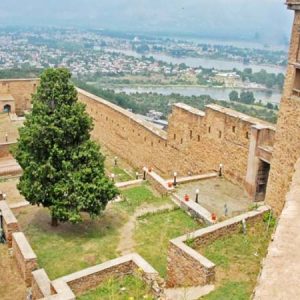
Origins of Hari Parbat Fort: A Historical Perspective Early Beginnings of the Fort
Hari Parbat Fort was built by the Mughal Emperor Akbar in the 16th century. The Mughals were very keen on the Kashmir Valley and established their dominance by building many architectural wonders in the region. Akbar, who was the epitome of military and administrative sagacity, decided to do so to strengthen the region further against external invasions into the region primarily from mountain passes in the north and northwest directions.
Its strategic position atop the Hari Parbat Hill, at an elevation of about 1,780 meters above sea level, facilitated the Mughals to oversee the surroundings and, therefore, have control over Srinagar and the valley that surrounded it. Initially a military stronghold, the fort became much more than that; it became a symbol of Mughal power, wealth, and architectural prowess.
Afghan and Dogra influence Although Hari Parbat Fort was originally constructed by Mughals, successive kings made many modifications and added several new parts to the fort. When the Mughal Empire started to decline in the early 18th century, this region came into the hands of Afghans. Afghans who occupied Kashmir, made the fort architecture become a living body through their own texture. A mosque was also established inside the fort complex under the Afghan Empire. To this day, it is one of the important religious places inside the fort.
It was taken over by the Dogra dynasty ruling the princely state of Jammu and Kashmir in the 19th century, and during this period Hari Parbat Fort once again saw significant changes. New buildings were added, and fortifications were renovated to adapt the fort to new political realities by the Dogras. The unique character of the fort is a blend of Mughal, Afghan, and Dogra architectural elements, making it an exceptional example of regional architectural amalgamation.
Architectural Design and Layout of Hari Parbat Fort
Architecture of Hari Parbat Fort is a beautiful amalgam of Mughal, Afghan, and local designs done in Kashmir, reflecting various influences that have evolved in the region in course of time. It is the architectural masterpiece from its towering walls to serene courtyards depicting military might and architectural beauty at its best.
The Fort Walls: A Defense Masterpiece
One of the most prominent features that could be attributed to Hari Parbat Fort would be the grand fortification wall. The colossal fortification walls had been erected on giant stones deliberately laid, as if it was trying to overcome the natural disaster and attacks from the army that could possibly occur, and the height up the fort at times rises to 20 feet to give space for great view for watching or defense.
The bastions and watchtowers on this fort are erected just so, aiding the vigil of soldiers across the valley. Soldiers at these points in the bastions would quickly respond to their surroundings-surrounded by mountains, or from looking down the valley. They give an image of ingenuity military mind at this period and the forte is centered upon defense.
Gate and Access Ports: Imposing Entrances
There are many gates to the Hari Parbat Fort that symbolize something special and carry an immense history in themselves. The most famous among them is Shah Kacheri, built during the Afghan period. It is the main entrance to the fort and has made an architectural wonder with carvings, inscriptions, and arches of varied forms, which form a fundamental feature of Afghan architecture.
Once again, aesthetically wonderful but also practical for defense in the scenario of invasion, the gate of the fort has been designed. The grand entrance also assumes that the fort is a strategic point in the region on a large scale of Mughal and Afghan control.
The Watchtower: Stretching across the Valley
Perhaps most defining of the fort is its watchtower that gives visitors 360-degree view of Srinagar and Kashmir Valley. Its strategic placement has been to track movements in and around the fort. It could also be the elevated position through which soldiers might spot approaching invaders, giving a tactical advantage in the fort that other military buildings in the area did not.
The tower stands out above the fort, giving an exhilarating view of Dal Lake and the city of Srinagar and the breathtaking snow-capped peaks of the Himalayas. The panoramic view is one of the major tourist attractions for both photographers and sightseers who visit the place. People take beautiful photographs of the natural view surrounding the fort while at the same time acknowledging the military as well as the architectural genius in the construction.
Inner Courtyards and Buildings: A Peep into the Mughal’s Elegance
Although the fort was basically a military establishment, it also had several courtyards and buildings that reflected the grandeur and aesthetic sensibilities of the Mughal emperors. The courtyards, though simple in design, are a peaceful abode from the military elements of the fort. The central courtyard, with various chambers and rooms surrounding it, was once used as a space for administration and gatherings.
Although the interior walls of the fort have eroded with time, one can still see a hint of the architectural features of the Mughal period, including arches, niches, and carvings. All these elements represent the significance of the fort as a military and cultural center. The stonework speaks of the richness of Mughal architecture through grand structures along with intricate artistry.
Religious Significance: A Symbol of Syncretism
One of the special features of Hari Parbat Fort is its religious and cultural importance to the people of Kashmir. The fort stands on a hill that has long been associated with spiritual importance. Historically, the hill was home to a temple dedicated to Goddess Parvati, the consort of Lord Shiva. Pilgrims from the Hindu community regularly visited the site to pay homage to the goddess.
Temple of Goddess Parvati
This ancient temple, dedicated to the Goddess Parvati, which serves as one of the principal religious centers of Hindus in that region, portrayed the tangibility of the divine and natural beauty of Kashmir Valley. Although now, not much remains of this original structure owing to the swift rush of time, the linkage of this hill with Goddess Parvati stays fresh in everyone’s memory.
At the bottom of the hill stands today a miniature shrine for this goddess. More pilgrims will come and bow before this god, offering sacrifices before seeking the divine’s blessing and protection. There is still its historical value associated with the fortress to the religious and cultural essence of the structure.
The Masjid: The Essence of Islamic Design
Apart from its Hindu associations, Hari Parbat Fort houses a mosque. This was during the Afghan rule. The mosque is one of the most exemplary Afghan and Islamic architectural designs; it consists of a big dome, minarets, and prayer halls. To this day, it remains a place of worship for Muslims in Srinagar.
A single fort covered all Hindu and Muslim religious places reflects the cultural diversities and syncretism characterizing Kashmir’s religious history. Such coexistence of the peace religion traditions within the physical space reflects the ability of this region to integrate various cultural influences within it.
Hari Parbat Fort as a Tourism attraction
Scenic view from Dal Lake and Srinagar
The magnificent view is the key attraction for which the tourists visit Hari Parbat Fort. From atop the fort, the view is not even partly obstructed towards Srinagar, Dal Lake, and the whole vast area of the Kashmir Valley. Dal Lake’s beauty in the snow-white mountains against glistening waters can’t be forgotten at all.
There, they can sit for hours snapping pictures or simply admiring the view. The site is historical, full of nature, and architecture- a must-go destination for anyone traveling to Srinagar.
Neighboring attraction: A historical circuit.
Hari Parbat Fort is part of a greater circuit of the historic and cultural heritage of Srinagar. Nearby lie some of the well-known Mughal Gardens such as Nishat Bagh, Shalimar Bagh, and Chashme Shahi. The Mughal era has bequeathed them, which are marvelously beautiful with great landscaping, fountains, and water features.
Other attractions close to the fort can be easily combined with a visit, and thus visitors can thoroughly submerge themselves in the grandeur of Kashmir’s royal heritage. The historical and natural attractions surrounding the fort give tourists an all-rounded experience.
Cultural Events and Festivals
Its other essential attractions are its artistic traditions, music, and dance and handcrafts based on Kashmiri culture, all of which can be viewed throughout the year at the Hari Parbat Fort during fairs and celebrations. It opens a glimpse to its rich heritage for the people to watch native artisans and artistes.
From traditional Kashmiri music to folk dance performances, these festivals bring a lively, vibrant atmosphere to anyone visiting the fort. Cultural events usually overlap with significant religious holidays or festivals, so travelers can easily get a taste of the full splendor of Kashmiri culture.
Hari Parbat Fort Preservation and Future
Given its historical, cultural, and architectural importance, there have been continuous efforts to preserve Hari Parbat Fort for the future. The fort walls, gates, and interiors have been restored through conservation work, though much remains to be done.
JKTDC and the Archaeological Survey of India are maintaining the fort and have attempted to preserve and conserve the fort. This is one of the most important heritage sites that exist in Kashmir, and the Hari Parbat Fort would continue to attract visits from all over the world and symbolize the cultural and historical wealth of Kashmir.
Conclusion: A Testament to Kashmir's Rich Heritage
Hari Parbat Fort stands, in living heritage, as diverse cultural, architectural, and religious pieces of Kashmir, which hold value for those approaching Srinagar by virtue of historical splendor combined with architectural splendor and scenic beauty. It cannot be called an ordinary structure because it is an epitome of the undying people who have always reflected the cultural flavor of this entire region of religion and various colors of the globe.
Hari Parbat Fort is not just a trip through history; it is an immersive journey into the soul of Kashmir. If you’re into history, architecture, religion, or simply want to enjoy the breathtaking views of the valley, come to Hari Parbat Fort – there’s simply no way you can afford to miss this.
How to book Kashmir tour?
Contact a travel agency that specializes in Kashmir tours. You can reach out to the following for assistance:
- Phone:
- +91 7889 655596
- +91 7006 891267
- Email:
Inquire about tour packages, itineraries, and pricing, and confirm your booking for a memorable winter experience!
People Also Ask
What is Hari Parbat Fort?
Hari Parbat Fort is a historic fort located in Srinagar, Kashmir. Built on a hilltop, it offers spectacular views of the city and Dal Lake. The fort has historical and cultural significance, with architecture influenced by Mughal, Persian, and local styles.
Where is Hari Parbat Fort located?
Hari Parbat Fort is located in the city of Srinagar, Kashmir, India. It is situated on the Hari Parbat hill, offering panoramic views of the city, Dal Lake, and the surrounding mountains.
Who built Hari Parbat Fort?
The fort was originally constructed by the Mughal Emperor Akbar in the 16th century. However, it was later expanded by Emperor Aurangzeb in the 17th century. The fort was built to strengthen the defense of Srinagar.
What is the significance of Hari Parbat Fort?
Hari Parbat Fort holds historical significance as it played a crucial role in the defense of Srinagar during the Mughal and Afghan rule. The fort also symbolizes the blending of different cultures and architectural styles.
What are the key attractions at Hari Parbat Fort?
Key attractions at Hari Parbat Fort include its stunning architecture, the Shankaracharya Temple at the top, the Kathi Darwaza (main entrance), and panoramic views of Srinagar and Dal Lake. The fort also houses inscriptions and historical artifacts.
Is there an entry fee for Hari Parbat Fort?
Yes, there is a small entry fee to visit Hari Parbat Fort. The fee helps in maintaining the fort and its surroundings. It is advisable to check for any updated entry fees before your visit.
How do I reach Hari Parbat Fort?
Hari Parbat Fort is located approximately 4 kilometers from the city center of Srinagar. You can reach the fort by taxi, rickshaw, or on foot from the city. The fort is also accessible by car or bike.
What is the best time to visit Hari Parbat Fort?
The best time to visit Hari Parbat Fort is during the spring and summer months (March to September) when the weather is pleasant. The fort offers breathtaking views during sunrise and sunset, especially in the autumn months when the surroundings are covered in vibrant colors.
Is Hari Parbat Fort open year-round?
Yes, Hari Parbat Fort is open to visitors year-round. However, visiting during the summer months provides the best experience in terms of weather and views.
What are the architectural features of Hari Parbat Fort?
Hari Parbat Fort features a blend of Mughal, Persian, and local Kashmiri architectural styles. Its design includes massive stone walls, bastions, gates, and a traditional Mughal-style entrance. The fort also houses a mosque and a Hindu temple at the top.
Is Hari Parbat Fort suitable for photography?
Yes, Hari Parbat Fort is an excellent spot for photography. The stunning architecture, historical significance, and panoramic views of Srinagar, Dal Lake, and the surrounding mountains make it a great location for both landscape and architectural photography.
Are there any religious sites at Hari Parbat Fort?
Yes, there are religious sites at Hari Parbat Fort. The fort is home to the Shankaracharya Temple, a Hindu temple dedicated to Lord Shiva. Additionally, there is a mosque and other smaller shrines within the fort complex.
Can I hike up to Hari Parbat Fort?
Yes, you can hike up to Hari Parbat Fort. There is a steep, scenic trail leading to the fort. It’s a great option for those who enjoy hiking and want to explore the surroundings while gaining beautiful views of Srinagar.
How long does it take to explore Hari Parbat Fort?
Exploring Hari Parbat Fort typically takes about 1 to 2 hours, depending on how thoroughly you wish to explore the historical structures, enjoy the views, and photograph the surroundings.
Can I take a guided tour of Hari Parbat Fort?
Yes, you can hire a local guide to take you through Hari Parbat Fort. A guide will help you understand the historical and cultural significance of the fort, as well as its architectural features.
What is the history of Hari Parbat Fort?
Hari Parbat Fort was originally built by Mughal Emperor Akbar in the 16th century and later expanded by Emperor Aurangzeb in the 17th century. It was used as a military stronghold and later came under the rule of the Afghan rulers before the arrival of the Dogra dynasty.
Are there any nearby attractions to visit after Hari Parbat Fort?
Yes, several nearby attractions include:
- Shankaracharya Temple: Located on a hilltop, it offers great views of Srinagar and Dal Lake.
- Dal Lake: Famous for houseboats and shikara rides.
- Nishat Bagh and Shalimar Bagh: Mughal gardens with stunning landscapes.
Is Hari Parbat Fort safe to visit?
Yes, Hari Parbat Fort is generally safe to visit. Like any historical site, it’s advisable to stay with a group, especially if you’re unfamiliar with the area. The fort is frequently visited by tourists, and the authorities take measures to ensure visitors’ safety.
What kind of clothes should I wear to visit Hari Parbat Fort?
Wear comfortable walking shoes and weather-appropriate clothing, especially if you plan to hike up to the fort. During summer, light and breathable clothing is recommended, while in winter, you should dress warmly as temperatures can drop significantly.
Are there any restaurants or food options near Hari Parbat Fort?
While there aren’t many food stalls or restaurants directly within the fort complex, there are various local eateries and cafes nearby in Srinagar where you can enjoy traditional Kashmiri cuisine after your visit.
Is Hari Parbat Fort wheelchair accessible?
Due to its hilly terrain and the steep nature of the ascent, Hari Parbat Fort is not fully wheelchair accessible. However, visitors with limited mobility can explore the lower sections and enjoy the views from the base of the fort.
Can I visit Hari Parbat Fort by shikara?
While you cannot directly reach the fort by shikara, you can take a shikara ride on Dal Lake, which offers picturesque views of the fort from the water. This is a unique way to enjoy the landscape around Hari Parbat.
What is the best time of day to visit Hari Parbat Fort?
The best times to visit Hari Parbat Fort are early in the morning or late afternoon. These times offer the best lighting for photography and allow you to experience the fort with fewer crowds.
What is the significance of the Shankaracharya Temple located at the top of Hari Parbat Fort?
The Shankaracharya Temple is an important Hindu pilgrimage site dedicated to Lord Shiva. It is located at the summit of the hill that houses Hari Parbat Fort and offers a stunning panoramic view of Srinagar. The temple has historical and religious significance and is one of the main attractions for visitors to the area.
What is the view from the top of Hari Parbat Fort like?
The view from the top of Hari Parbat Fort is breathtaking, offering a 360-degree panorama of Srinagar city, Dal Lake, and the surrounding mountains. The view is particularly striking at sunrise and sunset, making it an ideal spot for photography and sightseeing.



